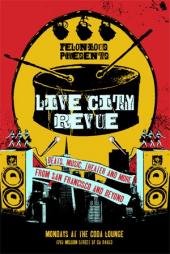 What’s it like to feel like an outsider in your own country? I think a lot of people living here in the so-called “Republic of California” feel like this when they read about pro-life groups gaining headway in the mid-west or the outlawing of the teaching of the Big Bang Theory in southern schools.
What’s it like to feel like an outsider in your own country? I think a lot of people living here in the so-called “Republic of California” feel like this when they read about pro-life groups gaining headway in the mid-west or the outlawing of the teaching of the Big Bang Theory in southern schools.
Not that the Bay Area way of life, with its yuppie brunches and hipsters fretting over whether their Thanksgiving turkey went to art school before it was humanely put to sleep, is necessarily preferable, mind you.
It is this duality that underpins solo theater artist and writer Dan Hoyle’s new show, The Real Americans, currently playing at The Marsh Theatre in San Francisco.
Put off by the hipster brunch crowd, the artist leaves the Bay Area bubble and sets off into the hinterlands in his van to find out what middle America is really like in the hopes of finding something that goes beyond the aforementioned cliches. Sadly for Hoyle — and for his audiences — he comes back to the Bay with his stereotypes mostly confirmed.
The show entertains us with its vivid characterizations of various hayseed and christian conservative types. But it ends up confirming typically San Franciscan liberal views about the rest of the country rather than providing any truly new insights into what it means to be a “real American” or if such a thing even exists today.
PS On the subject of national identity and belonging versus feeling like a stranger in your own land, the Akram Kahn dance company is coming to San Francisco’s Yerba Buena Center for the Arts this weekend with “Bahok”, the group’s acclaimed 2008 work which explores similar issues to Hoyle’s show. Taking its title from the Bengali word “carrier”, the piece mixes Chinese folk dance and Kathak influences with western contemporary and classical ballet techniques. It might be interesting to compare and contrast Hoyle’s and Kahn’s approaches to the subject of patrimony.

 The fabulous British all-male a cappella vocal ensembl
The fabulous British all-male a cappella vocal ensembl Arts events aren’t a common occurrence at City Hall in San Francisco. But they should be.
Arts events aren’t a common occurrence at City Hall in San Francisco. But they should be. At what point in an arts organization’s growth does it need to have more than one person at the top? I ask this question in light of the departure of the
At what point in an arts organization’s growth does it need to have more than one person at the top? I ask this question in light of the departure of the  Unlike many people who write about music, I keep all of my audio collection on my laptop computer, a MacBook air. The main advantages of doing this are that I have my entire music collection at my fingertips wherever I go, and I save a lot of shelf space that would otherwise be taken up with CDs gathering dust. I also love buying music online – it’s so quick and easy – and these days, you can find a surprising amount of unusual stuff via digital download.
Unlike many people who write about music, I keep all of my audio collection on my laptop computer, a MacBook air. The main advantages of doing this are that I have my entire music collection at my fingertips wherever I go, and I save a lot of shelf space that would otherwise be taken up with CDs gathering dust. I also love buying music online – it’s so quick and easy – and these days, you can find a surprising amount of unusual stuff via digital download.  American soprano Kiera Duffy is a rising star of the opera and concert stage. Since being a finalist in the 2007 Met National Council Auditions — and as such was featured in Susan Froemke’s documentary about the major opera competition, The Audition — she has gone on to great things. In 2008, she won a Sullivan Foundation grant and has performed with the New York Philharmonic and the Los Angeles Philharmonic as well as at Tanglewood and Carnegie Hall. Kiera took some time out of her busy schedule to pen her thoughts for lies like truth about The Audition‘s impact on her career…
American soprano Kiera Duffy is a rising star of the opera and concert stage. Since being a finalist in the 2007 Met National Council Auditions — and as such was featured in Susan Froemke’s documentary about the major opera competition, The Audition — she has gone on to great things. In 2008, she won a Sullivan Foundation grant and has performed with the New York Philharmonic and the Los Angeles Philharmonic as well as at Tanglewood and Carnegie Hall. Kiera took some time out of her busy schedule to pen her thoughts for lies like truth about The Audition‘s impact on her career… It’s official: Monday is the new Saturday and last night’s escapades in San Francisco are proof of this fact.
It’s official: Monday is the new Saturday and last night’s escapades in San Francisco are proof of this fact. Why are arts organizations so obsessed with anniversaries? Every day it seems, some museum, presenter, dance troupe, alternative arts space or theater company is celebrating a milestone birthday, be it 25, 50 or 75 years with a retrospective or special series of events of somesuch. But to what extent are anniversaries really worth observing from an artistic perspective? Or are they merely crutches for programming, pegs to attract media coverage or excuses for amping up fundraising efforts?
Why are arts organizations so obsessed with anniversaries? Every day it seems, some museum, presenter, dance troupe, alternative arts space or theater company is celebrating a milestone birthday, be it 25, 50 or 75 years with a retrospective or special series of events of somesuch. But to what extent are anniversaries really worth observing from an artistic perspective? Or are they merely crutches for programming, pegs to attract media coverage or excuses for amping up fundraising efforts?  The world is full of madcap ideas that don’t come to fruition. But thankfully there’s always a place to talk about them, even if they end up not getting realized.
The world is full of madcap ideas that don’t come to fruition. But thankfully there’s always a place to talk about them, even if they end up not getting realized. Do classic plays always lend themselves to adaptation into different cultural idioms? What makes a certain story resonate in particular with a particular setting? Luis Alfaro’s Oedipus el Rey, currently receiving its world premiere production at the
Do classic plays always lend themselves to adaptation into different cultural idioms? What makes a certain story resonate in particular with a particular setting? Luis Alfaro’s Oedipus el Rey, currently receiving its world premiere production at the  When I was growing up, I used to think it strange that the mother of a close friend of mine had empty antique picture frames covering almost every spare bit of wall in the entrance hall of her Victorian townhouse. The walls above the stairs were also covered in frames, making the surfaces of the house look like they were adorned with the whites of eyes.
When I was growing up, I used to think it strange that the mother of a close friend of mine had empty antique picture frames covering almost every spare bit of wall in the entrance hall of her Victorian townhouse. The walls above the stairs were also covered in frames, making the surfaces of the house look like they were adorned with the whites of eyes. The British TV show,
The British TV show,